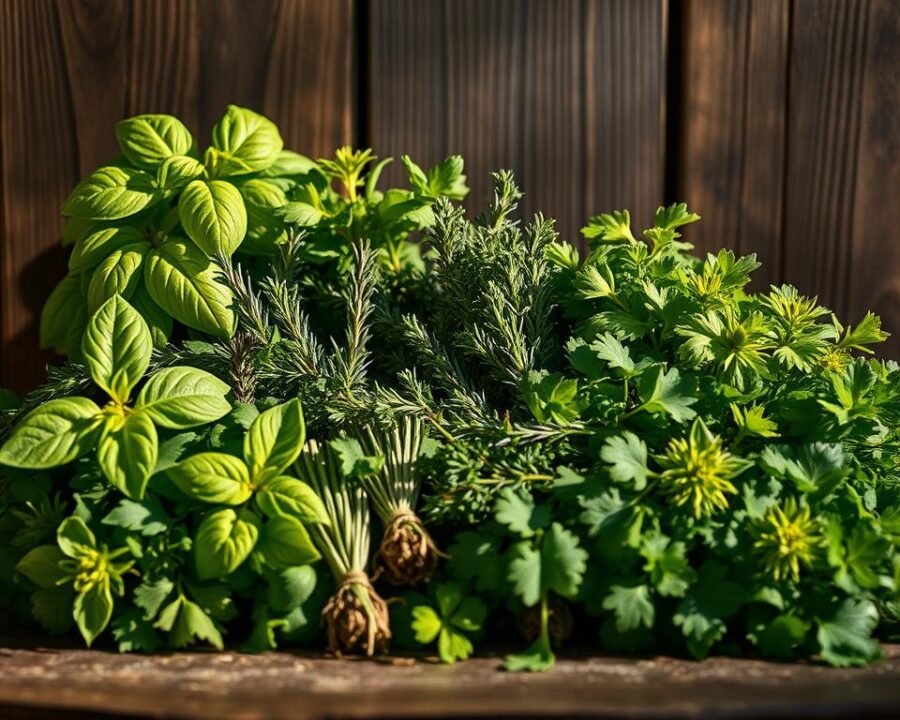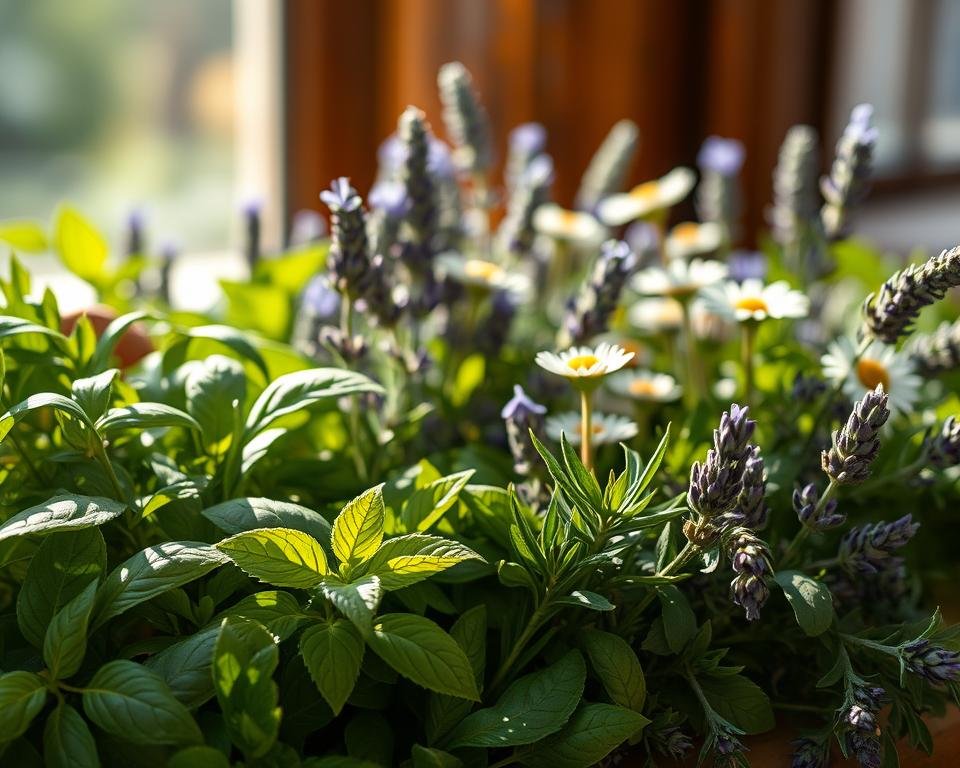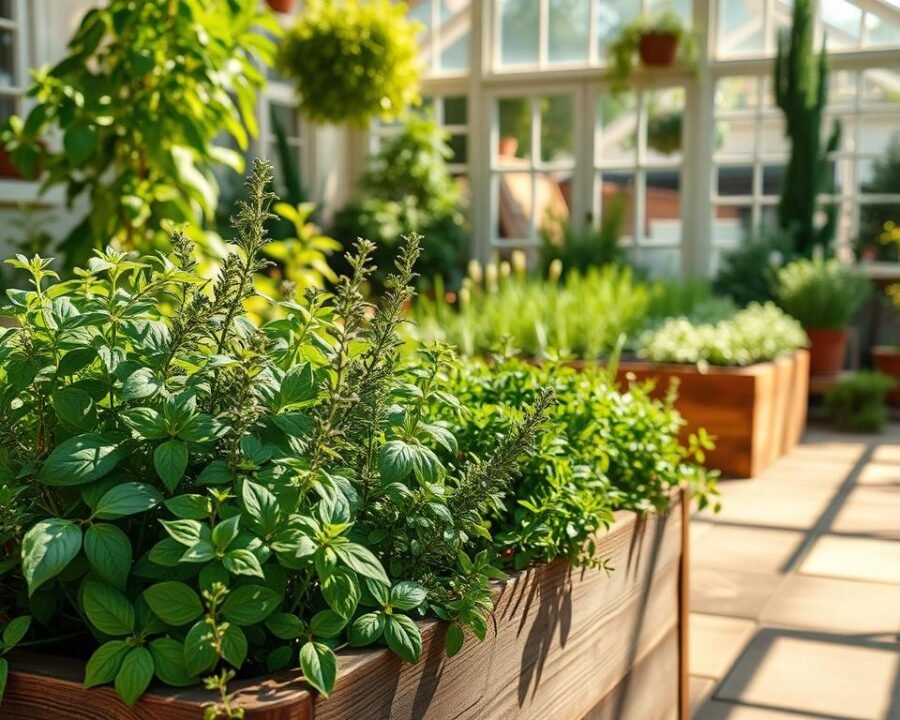Fresh, aromatic herbs can transform everyday meals into culinary delights. Whether snipped into soups, tossed in salads, or steeped in drinks, their vibrant flavor and health benefits make them a must-have. Even in small spaces, these plants thrive on a sunny windowsill or in compact containers.
Growing your own ensures a steady supply of nutrient-rich leaves, packed with vitamins and antioxidants. No backyard? No problem. Many varieties, like basil and thyme, adapt well to indoor settings. For inspiration, explore easy-to-grow options perfect for beginners.
Beyond cooking, herbs like lavender double as natural air fresheners and stress relievers. Their versatility makes them ideal for urban dwellers and seasoned gardeners alike. Ready to start? Let’s dive into the simplest ways to cultivate freshness at home.
Key Takeaways
- Fresh herbs enhance flavor and nutrition in meals.
- Compact spaces like windowsills work well for growing.
- Basil and lavender are beginner-friendly choices.
- Indoor gardening reduces stress and boosts well-being.
- Herbs serve both culinary and decorative purposes.
1. Easy-to-Grow Herbs for Beginner Gardeners
Starting a small indoor garden? These herbs easy to grow even for beginners. They adapt well to containers and thrive in a sunny spot, making them ideal for kitchens or balconies. With simple care, they’ll reward you with fresh foliage for salads, dishes, and more.
Basil: The Versatile Favorite
Basil’s vibrant leaves range from sweet Genovese to spicy Thai. Plant seeds in a 6-inch pot with drainage holes. Keep soil moist and trim regularly for bushier growth.
- Flavor profiles: Lemon basil (citrusy), Purple Ruffles (mildly peppery).
- Companion tip: Pair with tomatoes to deter pests naturally.
Mint: Fast-Growing and Refreshing
Mint spreads aggressively, so always use containers. Try spearmint for drinks or chocolate mint for desserts. A buried pot barrier prevents runaway roots.
Harvest with the cut-and-come-again method: Snip stems above leaf nodes to encourage regrowth.
Chives: Hardy and Onion-Flavored
Chives thrive in partial sun and produce edible purple flowers. Use them to garnish soups or mix into compound butter.
Container size: 8-inch diameter. Divide clumps every 3 years to maintain vigor.
Parsley: Mild and Biennial
Soak seeds overnight to speed up germination. Flat-leaf parsley packs more flavor than curly varieties. It’s a family-favorite for garnishes and sauces.
“Parsley’s biennial cycle means it blooms in its second year—harvest leaves before flowering for best taste.”
2. Culinary Powerhouses to Elevate Your Dishes
Certain herbs pack a punch in flavor, turning simple dishes into gourmet experiences. These culinary staples shine in roasts, soups, and global cuisines. Let’s explore four standout varieties that belong in every kitchen.

Rosemary: Robust and Piney
With notes of sage and lavender, rosemary adds depth to roasted meats and potatoes. Its woody stems thrive in dry conditions, making it drought-tolerant once established.
- Infused oils: Steep sprigs in olive oil for dressings or marinades.
- Winter care: Move potted plants indoors in freezing climates.
For more tips on growing rosemary and other medicinal herbs, check our guide.
Thyme: Earthy and Versatile
This low-growing herb stars in French, Middle Eastern, and Caribbean cooking. Lemon thyme brightens seafood, while caraway thyme complements hearty stews.
| Variety | Best Pairings |
|---|---|
| Lemon thyme | Fish, roasted vegetables |
| Caraway thyme | Pork, cabbage dishes |
Oregano: Spicy and Mediterranean
Greek oregano packs more heat than Italian varieties. Sprinkle it on pizza or mix into taco seasoning for an authentic kick.
“Mexican oregano actually comes from a different plant family—its citrusy notes work wonders in mole sauces.”
Cilantro: Bold and Polarizing
Love it or hate it, cilantro’s bright leaves define salsas and curries. A genetic trait causes some to perceive a soapy flavor.
- Harvest timing: Pick leaves before flowering for optimal taste.
- Preservation: Freeze chopped leaves in ice cubes for later use.
These herbs grow well together, sharing similar sunlight and watering needs. Their bold profiles make them indispensable for passionate home cooks.
3. Herbs with Remarkable Health Benefits
Beyond their culinary uses, many herbs offer impressive health perks. Research reveals compounds that aid digestion, reduce inflammation, and promote relaxation. These multitasking plants thrive equally well in backyard plots and kitchen containers.

Sage: Antioxidant-Rich and Aromatic
This Mediterranean native contains over 150 polyphenols, including rosmarinic acid. Studies suggest it may improve memory and lower blood sugar levels.
- Harvest timing: Pick leaves mid-morning after dew dries in summer.
- Anti-inflammatory use: Steep 1 tbsp fresh leaves in hot water for a sore throat gargle.
Dill: Digestive Aid with a Zesty Kick
Its carminative properties help relieve bloating and indigestion. The feathery flowers attract swallowtail butterflies, benefiting your entire garden ecosystem.
For quick relief, chew fresh sprigs after meals or brew with fennel seeds. Dill loses potency when dried—always use fresh for medicinal purposes.
Lemon Verbena: Citrusy and Calming
With 25% higher essential oil concentration than lemongrass, it’s ideal for tea. Nighttime blends combine well with chamomile and honey.
“Verbena’s limonene content promotes relaxation by activating GABA receptors in the brain.”
German Chamomile: Soothing and Floral
The daisy-like blossoms make compresses for irritated skin. For family-safe use, avoid during pregnancy due to mild uterine-stimulating effects.
- DIY salve: Infuse olive oil with dried flowers for 4 weeks, then mix with beeswax.
- Potency tip: Harvest flower heads when petals flatten horizontally for peak oil content.
Whether used fresh or dried, these botanicals bring wellness into daily life. Always consult an herbalist before internal use, especially for children or chronic conditions.
Conclusion: Start Your Best Herb Garden Today
Growing fresh herbs at home brings vibrant flavor and health benefits to every meal. Basil, rosemary, and chamomile stand out for their versatility—perfect for cooking, aromatherapy, and wellness. With just a sunny spot and well-drained soil, these plants thrive effortlessly.
Make sure to group containers by water needs—Mediterranean varieties like thyme require less moisture than mint. Check soil dryness before watering to prevent root rot. For year-round harvests, follow a seasonal planting calendar.
Ready to begin? Grab pruning shears and self-watering pots for a low-maintenance setup. Join local herb swaps or subscribe to expert newsletters for ongoing tips. Soon, that first harvest will inspire dishes like basil pesto or soothing chamomile tea.
Every small step counts. Start small, enjoy the process, and let nature do the rest.
